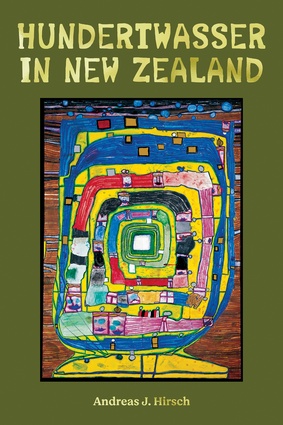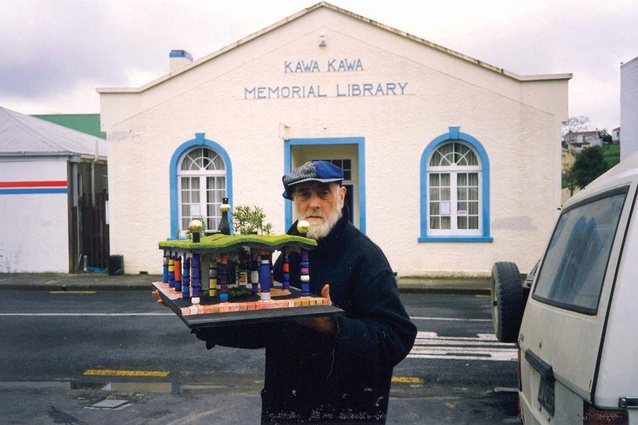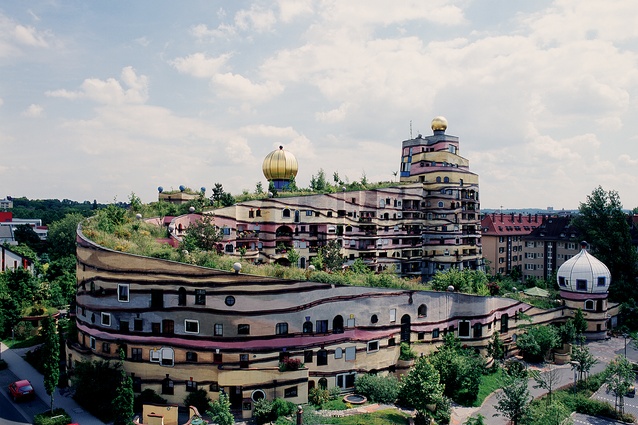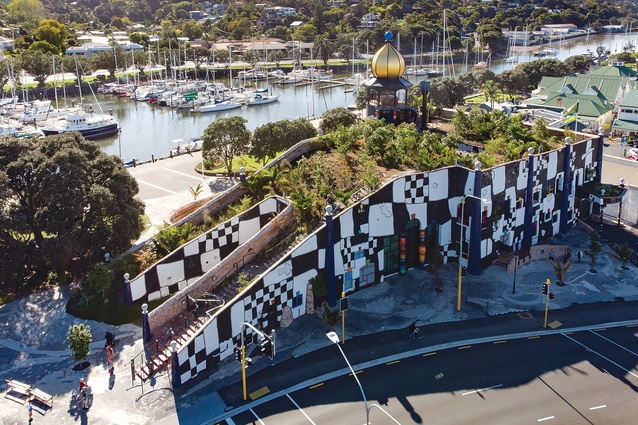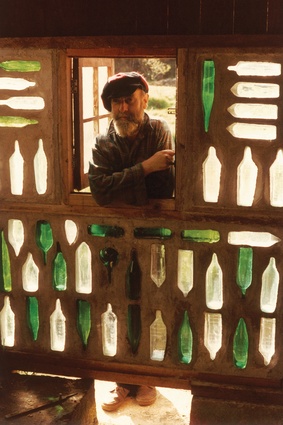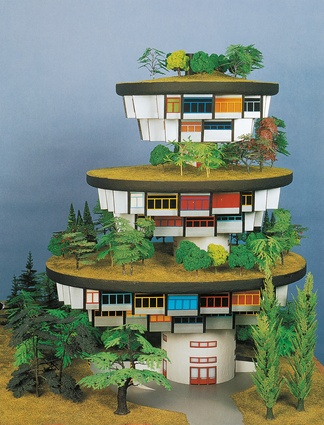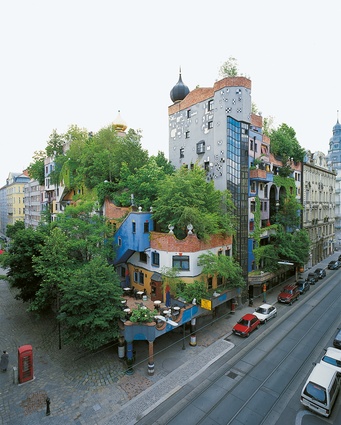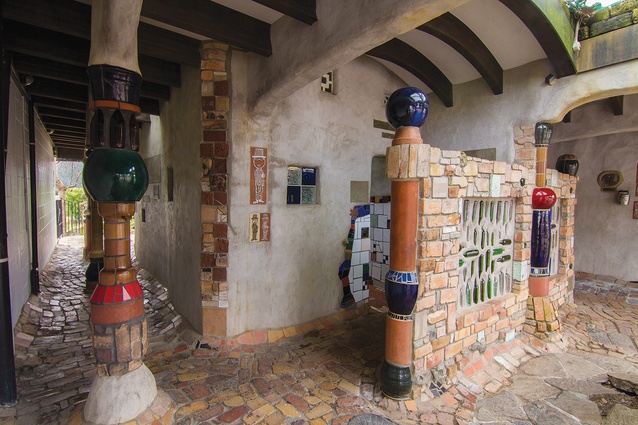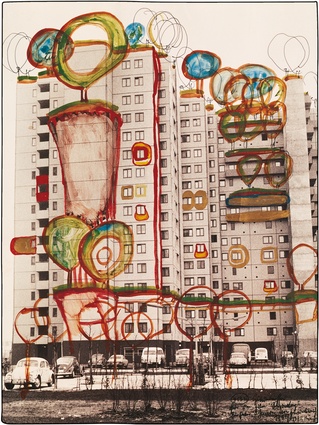Review: Hundertwasser in New Zealand – The Art of Creating Paradise
Bill McKay finds this latest book on Austrian architect Friedensreich Hundertwasser gives readers much to think about, including the nature of architectural history, what constitutes a New Zealand architecture and the role of émigré architects.
There were a few subversive little books circulating in the 1970s – Mao’s so-called Little Red Book and, of more relevance to teens, the “morally offensive” The Little Red Schoolbook (1969). The little black Hundertwasser book I rhapsodised about in my review of the new Hundertwasser Art Centre (HAC) in Whangārei (Architecture NZ March/April, 2022) may not seem subversive but, if you had the great misfortune to go to a boys’ high school in Hastings, it was a comfort at the end of a hiding on the sports field or a spot of bullying of “arty fartys”.
Sure, Hundertwasser’s work seems a bit hippie-ish now but to those of us who aspired to do architecture (me: literally one in a thousand at that school), who caught exhilarating glimpses of the work of Walker and Athfield through the pages of Designscape or New Zealand Architect, it was something else that could be brought to bear in overcoming provincial conservatism. Even though I turned to new wave and punk at uni (no mandalas, domes or woolly jumpers for me, thanks), I retain a soft spot for Hundertwasser. And, I also sneakily loved staff member Tony Watkins’ subversive-from-a-different-end-of-the-spectrum attitude and his handmade house in Karaka Bay. It was not just me that was a Hundertwasser fan; he did the poster for Conservation Week in 1974 and, of course, his Koru Flag of 1983 was enthusiastically adopted by many.
But, to the book. My visit to Hundertwasser’s most recent building in the world (not bad for a dead architect) prompted some fundamental questions about architecture: what it is, who or what it is for and how we do it. Hundertwasser in New Zealand is a translation of an eminent European curator’s work “initiated and edited by The Hundertwasser Non Profit Foundation, Vienna, for the Hundertwasser Art Centre with Wairau Māori Art Gallery, Whangārei”.
Hundertwasser arrived here for the opening of a touring show in 1973. The book touches on aspects of his early life in Europe and, in particular, the 1970s onwards, his to-ing and fro-ing from here to the rest of the world on his floating home, the boat Regentag, the art he did here or in-between and all that other biographical stuff. It is very well produced and illustrated, not just with his artworks but with photographs: Hundertwasser’s arrival on Regentag in dreary old Auckland, noted by the NZ Herald as “the only bright spot on the waterfront”, Hundertwasser as an early Auckland cycle commuter and so on. These details and others, such as participation in demonstrations, and opposition to heritage demolition and motorway construction, give us glimpses of an emerging liberal and progressive society and his involvement. What’s in it for architects? It includes coverage of the very public Kawakawa toilets that many of us have visited, his Bay of Islands home that very few of us know and, right up to date, the gestation, design and construction of the HAC.
As is anything from a northern hemisphere perspective, it’s a bit wobbly on insight into our culture/s and interaction over the human inhabitation and transformation of Aotearoa New Zealand, colonials supplanting mana whenua and our wrestling since then for an equilibrium. There is a fair amount of Eurocentric attitude, such as South Seas paradise/virgin land notions, although this is mostly Hundertwasser himself: “New Zealand is for me a kind of promised land… where you can find your way back to your origins” and “I must build paradise myself”. As an architectologist, just as the HAC raised questions for me about the nature of architecture, I consider this book to be useful in our thinking about the nature of architectural history, the canon (who’s who in architecture, who’s in, who’s out) and that old obsession of an adolescent country: who are we, what’s our identity and what constitutes a New Zealand architecture? The one thing that can be said about our current fad of retro-modernism is that we have a reprieve from worrying about that stuff.
This book is also a useful contribution to the emerging field of the role in a society of émigrés; such as European refugees during and after the Second World War. Also discussed are the place of Pacific people in an officially bicultural nation and the multicultural nature of super-diverse cities such as Auckland. Do the arts and cultures of immigrants contribute to or count as part of Aotearoa New Zealand-ness or are they still on the sidelines of the national game? For the general reader, this book is also valuable for a glimpse into the environmental activism and ecological awareness growing in this country from the 1960s onwards that paralleled Hundertwasser’s time here. It’s absolutely worth having for a whole lot of reasons, including owning one of those unfashionable things, beautiful books.
Hundertwasser in New Zealand – The Art of Creating Paradise
By Andreas J. Hirsch, translated by Uta Hoffmann
Oratia Books, August 2022

